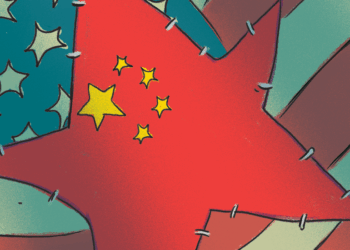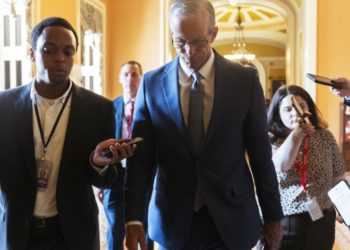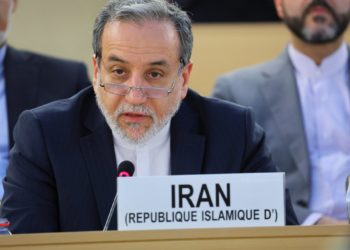India and Pakistan are now locked in their most expansive military conflict in decades. The two nuclear-armed states have been exchanging gunfire and shelling across their borders while also deploying missiles and drones, causing civilian casualties on both sides. The latest flash point between the two countries escalated on Wednesday after India attacked what it says were terrorist sites in Pakistan, in retaliation for a militant attack on civilians in Indian-administered Kashmir.
Are there any routes for de-escalation? On the latest episode of FP Live, I spoke with Tanvi Madan, a senior fellow at the Brookings Institution, and the author of Fateful Triangle: How China Shaped U.S.-India Relations During the Cold War. Watch the full discussion on the video box atop this page, or follow the FP Live podcast. What follows here is a condensed and edited transcript.
![]()
Ravi Agrawal: So Tanvi, let’s just start with April 22 as the flash point that began this new conflict. What do we know about what actually happened?
Tanvi Madan: What we know is multiple attackers targeted civilians—most of whom were tourists, and many on their honeymoons—visiting Pahalgam. What we also know is that there was a religious or communal dimension to it; the attackers targeted people on the basis of religion. This was the worst terrorist attack on civilians since the Mumbai attacks in 2008. And these are some of the reasons why the anger within India over this attack is quite high. There is anger in Kashmir as well, with some Kashmiris seeing it as an attempt to disrupt their economy. And because the victims came from over a dozen Indian states, there was kind of a national outpouring.
RA: This national anger led to a clear sense that India would respond. There’s a history of some recent escalation here, right?
TM: The Kashmir dispute itself goes back to the founding of India and Pakistan, as they currently exist, after the partition of the subcontinent by the British in 1947. But more recently, since the 1990s, India has accused Pakistan not only of using its military, but also using insurgents and terrorists to press their claims on Kashmir. Until 2016, you had not seen a military response from India, even under pressure after the 2008 Mumbai attacks. India showed considerable restraint. Then in 2016, the Modi government, which had come to power in 2014, said that it was going to respond militarily to a terrorist attack where a number of soldiers were killed. India conducted surgical strikes, sending soldiers from Indian-controlled Kashmir to the part Pakistan holds and conducted operations there. In 2019, there was another incident similarly with an attack on soldiers as well. You saw India respond again militarily, this time with airstrikes in Pakistan-controlled Kashmir and into the rest of the country.
RA: And then we fast-forward to this week. On May 7, after threatening to do so, India launches a fairly serious set of coordinated attacks fairly deep into Pakistan.
TM: Because of those 2016 and 2019 responses, there was an expectation that India would respond militarily. So India conducted military strikes within Pakistan on what they described in a government and military press conference as terrorist infrastructure. What was different from the 2019 responses is that India struck many more locations. The Indian side said nine. The Pakistanis, I think, admitted a few less, but nonetheless did acknowledge these strikes.
But it was also different because some of these strikes were in the province of Punjab, which is the heart of Pakistan in many ways. The Pakistani establishment is often dominated by Punjabis as an ethnicity. So this was not just quantitatively, but qualitatively, a different strike than the past.
RA: Now that India has gone further than it has in five decades, how might Pakistan game out a response? There’s a fog of war here, too. As India made these attacks on Pakistan, Pakistan, of course, claims that it shot down some Indian jets.
TM: Pakistan could have taken that point to follow one of three different options.
One, Pakistani officials have claimed that they have downed several Indian jets. The Indian side has not acknowledged it. [It now appears unnamed Indian officials admit at least one fighter jet was shot down.] But Pakistan could have used that claim to take an exit ramp, perhaps even portraying itself as a responsible actor showing restraint and even eliciting benefits from other countries to show that restraint.
A second option would have been retaliating, but keeping escalation below a certain threshold. When India struck, they made clear that they were purposely not striking military targets, in order to keep things from escalating further. So Pakistan could have taken the second option, targeting something in India that was below a certain threshold. The third option at that point: Pakistan could have actually upped the ante and attacked military facilities.
Meanwhile, while these decisions were being made, there was actual shelling, both mortar and artillery shelling, ongoing in the Kashmir area. India has acknowledged that civilians were killed in Jammu and Kashmir.
Now, New Delhi is saying that Pakistan chose option three, which is targeting military facilities through missiles and drones overnight and early [Thursday] morning. We do not have confirmation from the Pakistani side, but since then, India has retaliated with drone strikes into some cities in Pakistan.
RA: And a note to readers: We’re having this conversation on Thursday afternoon, Eastern Time. New developments will continue to emerge.
But Tanvi, just to zoom out, what are the prospects of international mediation here?
TM: A number of international actors are likely to be involved. Since the April 22 attack, both India and Pakistan engaged their partners. In Pakistan’s case, that’s China and Azerbaijan. In India’s case, it’s not just the U.S., but other Western countries like the Quad partners. Both have also engaged the members of the U.N. Security Council, including nonpermanent members. Pakistan happens to be one of those nonpermanent members right now.
Historically, international actors have taken an interest in de-escalating these crises, particularly since the two countries got nuclear weapons. It hasn’t always been mediation, but engaging with the country over whom they have the most leverage to persuade them. In some cases, it has been a little bit more formal in terms of intervention. There have been a number of phone calls since the Indian strikes. The Indian national security advisor called his counterparts in the U.S., Russia, China, and Europe, to discuss things with them. Pakistan also is briefing a number of their partners. But we haven’t seen a more active U.S. intervention, along the lines of what we’ve seen in the past.
RA: And that was the norm after India and Pakistan outed themselves as nuclear powers. In 1999, when Bill Clinton was concerned Islamabad was flirting with the nuclear option, he personally intervened to get the two sides to pull back. In 2001, after 9/11, when there was an attack on the Indian Parliament, [then-U.S. Secretary of State] Colin Powell spent a lot of time in New Delhi and Islamabad. Is that era of intense American diplomacy on India and Pakistan and intervention gone?
TM: Even if it’s not gone, the nature of American intervention has changed. India and Pakistan are very different and have different relationships with the U.S., for instance. In earlier crises, the U.S. and China coordinated to push for de-escalation. But today, the India-China rivalry is the worst it’s been since the two countries fought a war in the 1960s. In the past, the U.S. and Pakistan were also more engaged, especially when the U.S. was working closely with Pakistan in Afghanistan. Today, the U.S. is perhaps India’s closest partner. It sees India as crucial for its goals of balancing China, and as an economic alternative and a trusted technology partner. On the U.S.-Pakistan front, relations have been strained. So the two countries who used to intervene, China and the U.S., have fundamentally different relationships with the actors involved. Second, the U.S. and China themselves are not in a place to coordinate.
You’ve seen a different cast of international actors now playing a role. Saudi Arabia and UAE [the United Arab Emirates], which do have some leverage with Pakistan, earlier used to play a more supportive role, so were not seen as honest brokers. But today they have close relations with India as well. And so they could potentially get involved. Russia has been taking more of a neutral role. In 2019, it even offered to mediate, much to India’s chagrin. This time, Russian statements even called for Indian restraint. The Indians pushed back on that and then Russia issued a slightly more supportive statement. And then there’s the U.K., which continues to have close ties, particularly with the Pakistani military. That’s another change: The U.S. used to have those ties with Pakistan’s military.
Today, India has greater capabilities and an ability to resist pressure from countries. Whether it’s the Europeans or the U.S., they have other goals with India that they don’t want to actually adversely affect. And so they’re not getting as involved.
And then finally, this Trump administration does not seem to want to get deeply engaged. Secretary of State and interim [National Security Advisor Marco] Rubio has called the Indian foreign minister, the Indian national security advisor, and Pakistani officials as well. But we are not seeing the shuttle diplomacy or intense working-level calls that you saw before.
RA: So Tanvi, let’s talk about the possibilities of de-escalation between New Delhi and Islamabad using their interests. I see three potential frameworks. The first looks at their military capabilities. The second is what is in their naked self-interest. And then third, there’s a media game here. I just published a piece on this. But let’s tackle that first one: India’s economy is 11 times bigger than Pakistan’s right now, but on the battlefield in military terms, India’s military advantage does not seem 11 times greater.
TM: That’s right. India still has a conventional advantage. It can also sustain a war for longer, partly because of that economic heft. Pakistan’s economy has been suffering. They are dependent on getting loans, including from the IMF [International Monetary Fund].
But nonetheless, for all the Pakistani economy has suffered, the military does get a hefty defense budget. They’ve also been modernizing their military through relationships with China and Turkey. So Pakistan makes up for its conventional disadvantage.
Having said that, India has a larger navy, better cyber and space capabilities than they had in the past, and air defenses, some of which were acquired from the Russians.
But some of the constraint on the Indian side is that it still needs to defend its border with China, who happens to be Pakistan’s closest partner. China doesn’t necessarily have to do anything to still be something India has to think about. Could they make some maneuvers, take opportunistic action, and find ways to ease pressure on the Pakistan side?
The second thing that will shape how much this escalates is the constraints for suppliers of both India and Pakistan. India’s military is dependent on, or has relied on, places like Russia, Ukraine, and Israel for its munitions. All of those have conflicts of their own.
The third potential constraint is mother nature. As monsoon season sets in, the rains may affect how many operations can be conducted.
RA: The second lens through which to analyze potential de-escalation is self-interest. Let’s start with [Indian Prime Minister Narendra] Modi: What is in his self-interest here? What does he need in order to claim success as he emerges from this skirmish?
TM: So I’d zoom out and ask: What is India’s self-interest? There’s a sense that Modi needs to take certain actions because he’s under political pressure. But he doesn’t even have an election in the offing. And secondly, the opposition really united behind the government.
Having said that, if you look at what India will want out of this, they have made it clear that they want to send a message. They wanted their strike to have both a punitive dimension and also disrupt, if not deter, the camps that they targeted. They wanted to send the message that they do not fear escalation.
India’s self-interest also has a potential for non-escalation. Look at what India was focused on before this terrorist attack. It was focused on being a regional power, not just in South Asia but in Asia. It was talking about a multipolar world in which it was one of the poles. It was looking at its 6 percent growth and wanting to speed that up, create more jobs, and sign more trade deals. India wanted to focus on their strategic side, on their rivalry with China, and does not want to get bogged down with Pakistan.
RA: And what are Pakistan’s interests in this conflict? To walk through the cast of characters: you have Prime Minister Shehbaz Sharif, but the real power lies with its army general, Asim Munir, who also happens to be a former spy chief. And of course, Pakistan’s spy agencies have long had associations with the very militant groups that we began this conversation with.
TM: There could be an escalatory dimension here, because the Pakistani military, led by Gen. Asim Munir, has taken some reputational hits domestically in recent years. Some of it has been on the military front, since the U.S. snuck in to take out Osama bin Laden. But India, Iran, and Afghanistan also have gone across the Pakistani border with airstrikes. So the Pakistani military then has to make the argument to the public that it deserves the big budget that could be otherwise going into other civilian items. And it is in their interest to show that they continue to be effective defenders of Pakistan. The Pakistani military has taken another reputational hit as people talk about the military interfering too much in politics. Supporters of the previous Pakistani leader, Imran Khan, have protested against the Pakistani military because they felt he was removed on behest of the military.
I would just caveat, it also depends on the advice he might be getting from others who say to him, “You have inflicted certain losses on India, so take that as a win, shape the narrative, and then end this.” Or you could have a circumstance where people say to him, “If this keeps escalating, you might have more losses, and then it looks like you are ineffective.” So you could see that as an exit ramp. I think it depends a lot on Gen. Munir.
RA: This idea of shaping the narrative is the final de-escalatory option that I wanted to put out there. And it is also an argument I make in an essay I just published. India and Pakistan, like many countries around the world, have fairly jingoistic media ecosystems that will likely buy a government line claiming victory on both sides and then de-escalate. Of course, that’s just a theory. What’s your sense of whether that is a likely option or just a ray of light in this moment?
TM: Much like all the factors we’ve discussed, they can be escalatory by putting misinformation out there and ginning up the pressure. And so, it’s been good to see that at least the rhetoric of the Indian government, Indian military, and Indian keyboard warriors indicates that they will only escalate further if there is more escalatory behavior from Pakistan.
Having said that, because both governments in Pakistan and India have an ability to shape the narrative, as you said, these are potential off-ramps. So for example, the Pakistani military could have taken the off-ramp after claiming they took down Indian jets. You don’t even need evidence or confirmation, you can just say it happened and take that as an off-ramp if you choose to. But that requires leaders who want to do so.
The post The Potential Off-ramps for India and Pakistan appeared first on Foreign Policy.




